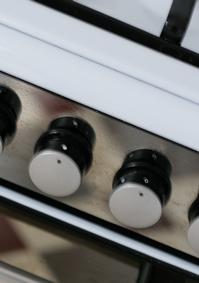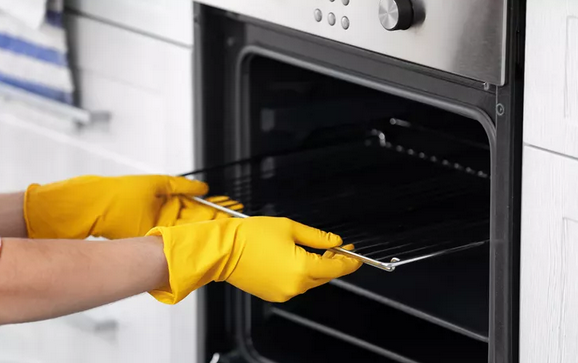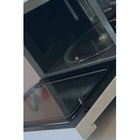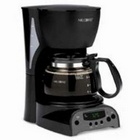There are very few secrets to how to clean an oven. Like most housework, it comes down to the timely application of a little elbow grease. Even self-cleaning models will occasionally need their glass doors shined, and stove tops on all models should be regularly wiped.
Self Cleaning Ovens

The arrival of new technology has really helped to alleviate the arduous chore of oven cleaning. Please consult your owner’s manual to see what type of oven you own and how to clean it.
If you do have a self-cleaning oven, be sure to remove racks and clean them separately, as many will be deformed or discolored by the high-temperature cleaning cycle. After running the cleaning cycle, you can use a vacuum with a hose attachment to remove the dust that is left behind, then a damp cloth to finish.
Even if you have a self-cleaning oven, you may still wish to clean the interior with an occasional wipe instead of using the time and energy to run a cleaning cycle.
In your clean oven I suggest cooking an amazing dish with this Pollo regio chicken recipe.
How to Clean an Oven – Step by Step
Step 1. Remove all knobs, racks, burner drip pans, and any other accessories. These can be washed by hand in the sink or in the dishwasher. If they a really grimy, place them in a well-sealed garbage bag filled with one cup of ammonia overnight. In the morning wash them in the sink with hot soapy water, then rinse and dry them.
Step 2. Remove all crumbs and other bits from the oven and stovetop. I just use the hose attachment on my vacuum – bye, bye bits.
Step 3. Protect the floor around your oven with an old sheet or some towels.
Step 4. Spray all surfaces with the oven cleaner of your choice. If you are using a commercial product, follow the instructions carefully, wear protective gloves, and ventilate the room. There are some natural oven cleaner options that may offer all the muscle you need to get the job done and you won’t have to feel like you’re going to war to get your oven clean.
Step 5. Allow the cleaner to do its work. Really, just let it be. Who knew how cleaning an oven was going to be so easy?
Step 6. Wipe up the cleaner with a damp cloth, rinsing often in the sink. Once you have thoroughly wiped out the inside of the oven, you may need to apply a second round of cleaner. When you are satisfied that things are clean, finally wipe with a clean cloth and hot water, then dry the surfaces. I like to run the oven empty for at least 30 minutes at 400°F after cleaning (especially with anything harsh). This allows any traces of the cleaning product to dissipate.
How to Clean an Oven – Glass Doors
Glass oven doors seem like a good idea, allowing you to peek in on whatever is baking, but the inside of the door can quickly become murky with splattered, baked-on grease, no matter how careful you are. Fortunately, cleaning an oven window isn’t hard with the right equipment.
What you’ll need:
- White vinegar in a spray bottle
- Baking soda
- Utility razor
Spray the dirty glass with vinegar and allow it to sit for 10 minutes to loosen and dissolve the grease. Use the razor blade to scrape off all grease spots. Sprinkle the glass with several tablespoons of baking soda, and using a cleaning cloth, rub it all over the door in circular motions. This will get rid of the overall brown haze. Wipe clean with a damp cloth.
How to Clean an Oven with a Steam Cleaner
A steam cleaner can really help out when it comes to cleaning an oven. If you have large areas of spattered and baked-on grease, you will still need to use some sort of oven cleaner, but the steam cleaner will work great on fresh stains and it can’t be beaten for getting into hard-to-reach cracks and hinges.
I use a home steam cleaner with a nozzle attachment to regularly detail my oven and stovetop. This keeps it looking new and saves me from having to do an all-out Saturday morning oven cleaning.
Cleaning Stove Tops
Now that we’ve mastered how to clean an oven, the stovetop deserves special consideration. How you clean this is going to depend upon the surface. Enamel stove tops are quite common so I’ll cover that here. For other surfaces, please consult your owner’s manual.
Never use tough abrasives on an enamel surface. You can scratch it and the scratch will then quickly oxidize leaving you with rusty marks. Better to live with a few grease spots than to ruin the surface of your stovetop.
Allow the stove top to completely cool before applying any product. I find that spraying the surface with vinegar to dissolve the grease, and then scrubbing with baking soda (a very mild but surprisingly effective abrasive) and a damp cloth will completely remove anything on the stovetop, even things that have been ignored for months.
Keeping Your Oven Clean
One of the best ways to save yourself time and frustration is to just keep the oven clean.
Use Protection. Whenever you use the oven, line the bottom tray or a cookie sheet with aluminum foil and place this underneath whatever you are baking. When the aluminum foil is soiled just gather it up and throw it away – now that’s a lot easier than scrubbing.
Use Salt. If you do spill in the oven, immediately cover it with a generous amount of salt, which will absorb the spill. When the oven cools, you can easily wipe up most of the mess.
Wipe Every Time. When you spill on the stove top, wipe it up immediately. Make cleaning the stove top part of the routine kitchen pick-up. If you just wipe the stove after every use, it will stay very clean.




